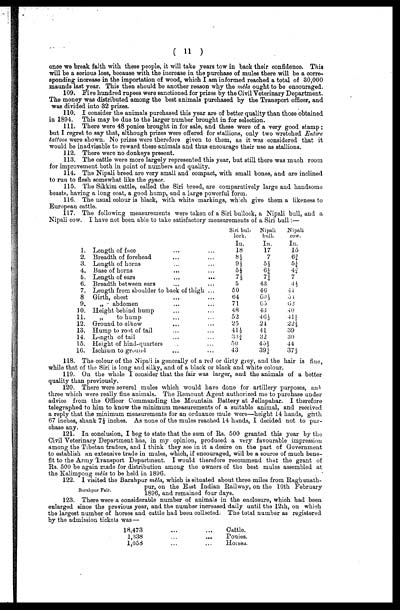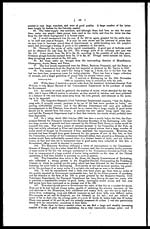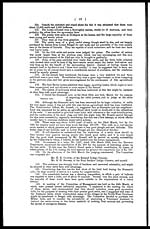Medicine - Veterinary > Civil Veterinary Departments > 1895-1951 - Annual report of the Civil Veterinary Department, Bengal > 1895-1896 - Annual report of the Civil Veterinary Department, Bengal, for the year 1895-96 > Annual report of the Civil Veterinary Department, Bengal, for the year 1895-96
(15) Page 11
Download files
Individual page:
Thumbnail gallery: Grid view | List view

(11)
once we break faith with these people, it will take years tow in back their confidence. This
will be a serious loss, because with the increase in the purchase of mules there will be a corre-
sponding increase in the importation of wood, which I am informed reached a total of 30,000
maunds lastyear. This then should be another reason why the mêla ought to be encouraged.
109. Five hundred rupees were sanctioned for prizes by the Civil Veterinary Department.
The money was distributed among the best animals purchased by the Transport officer, and
was divided into 32 prizes.
110. I consider the animals purchased this year are of better quality than those obtained
in 1894. This may be due to the larger number brought in for selection.
111. There were 48 ponies brought in for sale, and these were of a very good stamp;
but I regret to say that, although prizes were offered for stallions, only two wretched Entire
tattoos were shown. No prizes were therefore given to them, as it was considered that it
would be inadvisable to reward these animals and thus encourage their use as stallions.
112. There were no donkeys present.
113. The cattle were more largely represented this year, but still there was much room
for improvement both in point of numbers and quality.
114. The Nipali breed are very small and compact, with small bones, and are inolined
to run to flesh somewhat like the gynce.
115. The Sikkim cattle, called the Siri breed, are comparatively large and handsome
beasts, having a long coat, a good hump, and a large powerful form.
116. The usual colour is black, with white markings, which give them a likeness to
European cattle.
117. The following measurements were taken of a Siri bullock, a Nipali bull, and a
Nipali cow. I have not been able to take satisfactory measurements of a Siri bull:—
|
Siri bul- |
Nipali |
Nipali |
||
|
lock. |
bull. |
cow. |
||
|
In. |
In. |
In. |
||
|
1. |
Length of face |
18 |
17 |
15 |
|
2. |
Breadth of forehead |
8½ |
7 |
6 3/4 |
|
3. |
Length of horns |
9 ½ |
5½ |
5¼ |
|
4. |
Base of horns |
5½ |
6¼ |
4¼ |
|
5. |
Length of ears |
7½ |
7¼ |
7 ¼ |
|
6. |
Breadth between ears |
5 |
43 |
4½ |
|
7. |
Length from shoulder to back of thigh |
50 |
46 |
41 |
|
8 |
Girth, chest |
64 |
60½ |
51 |
|
9. |
„ abdomen |
71 |
65 |
62 |
|
)0. |
Height behind hump |
48 |
43 |
40 |
|
11. |
„ to hump |
52 |
46½ |
41½ |
|
12. |
Ground to elbow |
25 |
24 |
22½ |
|
13. |
Hump to root of tail |
41½ |
41 |
39 |
|
14. |
Length of tail |
33 3/4 |
32 |
30 |
|
15. |
Height of hind-quarters |
50 |
43½ |
44 |
|
16. |
Ischium to ground |
43 |
39 ½ |
37½ |
118. The colour of the Nipali is generally of a red or dirty grey, and the hair is flue,
while that of the Siri is long and silky, and of a black or black and white colour.
119. On the whole I consider that the fair was larger, and the animals of a better
quality than previously.
120. There were several mules which would have done for artillery purposes, and
three which were really fine animals. The Remount Agent authorized me to purchase under
advice from the Officer Commanding the Mountain Battery at Jellapahar. I therefore
telegraphed to him to know the minimum measurements of a suitable animal, and received
a reply that the minimum measurements for an ordnance mule were—height 14 hands, girth
67 inches, shank 7½ inches. As none of the mules reached 14 hands, I decided not to pur-
chase any.
121. In conclusion, I beg to state that the sum of Rs. 500 granted this year by the
Civil Veterinary Department has, in my opinion, produced a very favourable impression
among the Tibetan traders, and I think they see in it a desire on the part of Government
to establish an extensive trade in mules, which, if encouraged, will be a source of much bene-
fit to the Army Transport Department. I would therefore recommend that the grant of
Rs. 500 be again made for distribution among the owners of the best mules assembled at
the Kalimpong mêla to be held in 1896.
Barabpur Fair.
122. I visited the Barabpur mêla, which is situated about three miles from Raghunath-
pur, on the East Indian Railway, on the 10th February
1896, and remained four days.
123. There were a considerable number of animals in the enclosure, which had been
enlarged since the previous year, and the number increased daily until the 12th, on which
the largest number of horses and cattle had been collected. The total number as registered
by the admission tickcts was—
|
18,473 |
... |
... |
cattle. |
|
1,438 |
... |
... |
Ponies. |
|
1,058 |
... |
... |
Horses. |
Set display mode to: Large image | Zoom image | Transcription
Images and transcriptions on this page, including medium image downloads, may be used under the Creative Commons Attribution 4.0 International Licence unless otherwise stated. ![]()
| Permanent URL | https://digital.nls.uk/75720164 |
|---|
| Description | Title on spine: Civil Veterinary Department Bengal. Reports 1895-96. |
|---|---|




